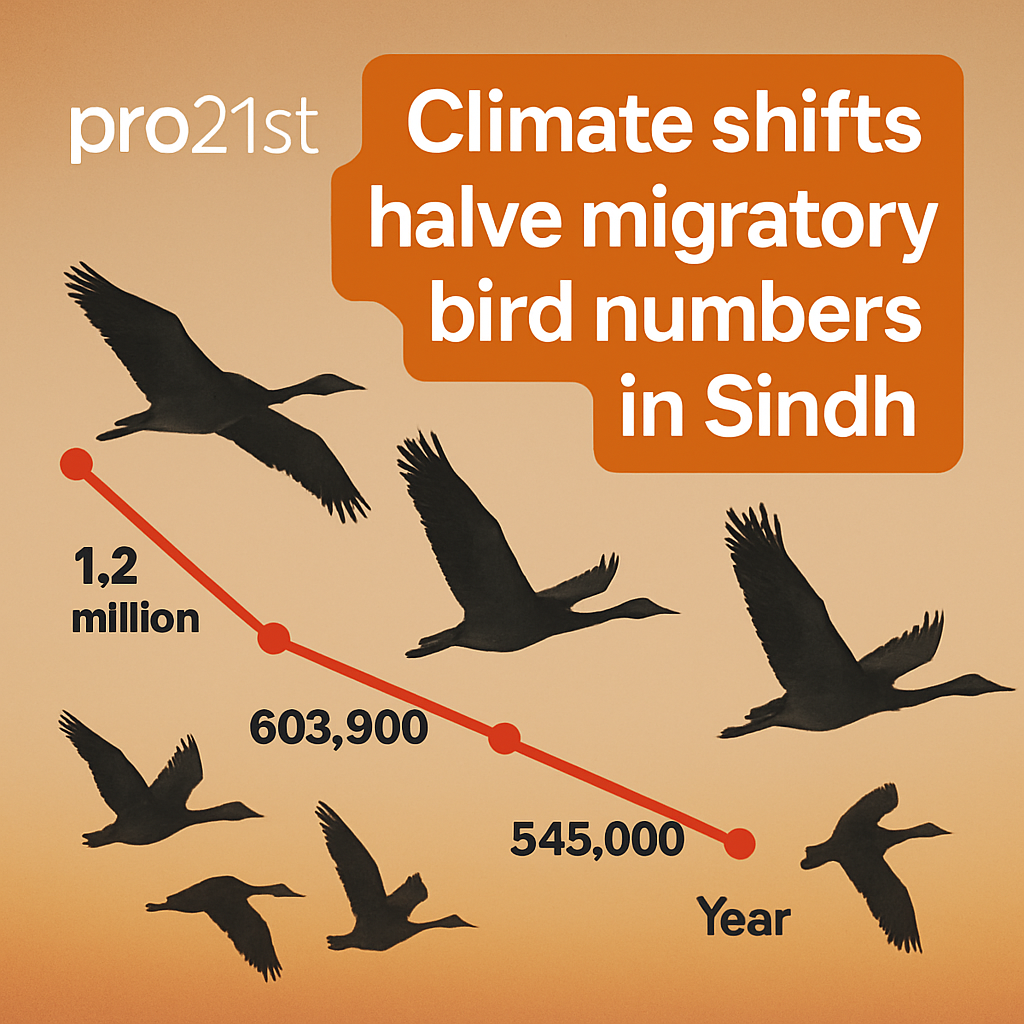Climate Shifts Halve Migratory Bird Numbers in Sindh: Pakistan’s Wetlands in Peril
When the crisp Siberian air gives way to harsh winters, millions of migratory birds embark on an epic journey stretching over 4,500 kilometers—a journey that, for generations, found respite in Pakistan’s thriving wetlands. Now, this legacy is under imminent threat. Climate shifts have halved migratory bird numbers in Sindh over just two years, and the once-crowded skies are alarmingly sparse. Experts warn that a mix of prolonged drought, shrinking water bodies, and rampant habitat degradation is pushing these winged travelers away—some, perhaps, forever.
## Pakistan’s Wetlands: A Once-Vibrant Sanctuary Now in Decline
Wetlands of southern Sindh, including iconic sites like Manchar Lake and the Ramsar-certified Keenjhar Lake, used to echo with the calls of thousands—cranes, mallards, snipes, and more—each winter. Historically, these wetlands served not only as migratory stops but also as critical breeding and feeding grounds, supporting local biodiversity and communities alike.
### The 2024-25 Waterfowl Count: Migratory Birds Plummet by Over 50%
According to the Sindh Wildlife Department’s 2024-25 waterfowl census, the situation is stark:
– **2023:** 1.2 million migratory birds
– **2024:** 603,900 birds
– **2025:** 545,000 birds
This staggering decline of over 50% within just two years is a wake-up call for conservationists, policymakers, and the public.
In 2023, the floods of the previous year had revitalized lakes, lagoons, and marshes, offering lush stopovers for weary avian travelers on the Indus Flyway. But as the remnants of the floods dried up, droughts and erratic rainfall left Pakistan’s renowned wetlands parched and inhospitable.
## How Climate Change and Human Activity Are Decimating Bird Habitats
### Prolonged Drought and Receding Water Levels
Sindh, long cherished for its rich biodiversity and myriad water bodies, is now languishing amid receding water levels and persistent drought. Wildcats like Manchar, Keenjhar, Hamal, and Haleji are experiencing historic water shortages. Even the marshy expanse of the Rann of Kutch Wildlife Sanctuary—a key haven for migratory waterfowl—has not been spared.
**Key factors driving habitat loss in Sindh’s wetlands:**
– **Shrinking surface water** due to reduced rainfall and upstream diversion
– **Increased salinity** from seawater intrusion and lack of freshwater replenishment
– **Disrupted food chains** as aquatic life declines
– **Habitat fragmentation** from expanding development and agriculture
### Human-Induced Habitat Degradation and Illegal Hunting
Climate change isn’t acting alone. Both ornithologists and wildlife officials point to human-induced threats:
– Unchecked land reclamation and encroachments degrade sensitive wetland ecosystems.
– Pollution—from industrial runoff to household waste—fouls waters, reducing food availability for birds.
– Although anti-poaching laws have been tightened, illegal hunting and trapping remain rampant, especially in the Kirthar mountains and Karachi’s coastal belt.
– Birds are still openly sold in illegal wildlife markets, undermining conservation gains.
## Migratory Patterns Disrupted: Fewer Flocks, Fading Species
### A Seasonal Phenomenon in Steep Decline
By late August each year, the first waves of migratory birds used to arrive in southern Pakistan, lingering till February. Traditionally, over 50 species cross this corridor—from the elegant cranes and storks to the resilient cormorants and dazzling plovers.
This year, the Sindh Wildlife Department’s survey—covering 40% of the province—reported:
– **Nareri Lagoon:** 112,000 birds (down from historic highs)
– **Rann of Kutch:** 91,000 birds
Even these relatively high numbers are mere echoes of the once-magnificent flocks.
### Punjab and Beyond: A Nationwide Trend
While Sindh showcases the most dramatic drops, Punjab is also reporting a gradual downward trend. According to Mudasser Hasan, deputy chief at the Punjab Wildlife Rangers, “The arrival of these birds in Pakistan is a seasonal migration, and it has understandably been disturbed because of seasonal disturbances.”
## Pakistan: On the Frontline of Global Climate Vulnerability
Pakistan is among the world’s top 10 most climate-vulnerable countries. Shifting monsoon patterns, glacial melt, and rising average temperatures threaten not only wetlands but the broader web of life. These stressors are compounded by:
– Increasingly erratic rainfall and prolonged dry spells
– Disrupted agricultural cycles impacting river flow
– Watershed degradation upstream
## Urgent Steps Needed: How Can Pakistan Save Its Wetlands and Birds?
### Strategic Actions to Reverse the Decline
To halt and reverse the staggering decline of migratory birds in Sindh and beyond, a multipronged conservation approach is essential:
1. **Wetland Restoration:**
– Rejuvenate priority lakes and marshes with managed water releases and community-driven replanting of native vegetation.
2. **Strengthen Enforcement:**
– Crackdown on illegal hunting and wildlife trafficking, especially in known poaching hotspots.
– Expand patrols and surveillance with local community engagement.
3. **Climate Adaptation Measures:**
– Develop and implement comprehensive water management plans that prioritize ecological flows for wetlands.
– Restore catchments to reduce siltation and bolster the resilience of these ecosystems.
4. **Public Awareness and Community Involvement:**
– Educate local populations about the ecological and economic value of wetlands and avian tourism.
– Support alternative livelihoods to reduce dependence on wetlands exploitation.
5. **Research and Monitoring:**
– Fund long-term monitoring to track bird populations and ecosystem health, enabling adaptive management practices.
### Why Saving Sindh’s Wetlands Matters
Healthy wetlands are not just bird habitats—they support local fisheries, act as natural flood guards, purify water, and anchor rural economies. Their loss would strike at the heart of Pakistan’s natural and cultural heritage.
## Frequently Asked Questions
**1. Why have migratory bird numbers dropped so sharply in Sindh?**
The primary causes include prolonged drought, falling water levels, habitat degradation, and persistent human interference such as illegal hunting and pollution.
**2. Which migratory birds visit Pakistan’s wetlands?**
Common visitors include cranes, storks, mallards, plovers, cormorants, snipes, and gulls, among over 50 recorded species.
**3. Are floods beneficial for wetlands and migratory birds?**
While devastating to communities, major floods can temporarily revive wetlands by replenishing water, supporting food webs that benefit migratory birds. However, the benefit is often short-lived if not followed by sustainable water management.
**4. What can be done to protect Pakistan’s wetlands?**
Restoring water flows, enforcing hunting bans, curbing pollution, community education, and proactive climate adaptation are all crucial steps.
**5. Is hunting still a major threat to migratory birds in Pakistan?**
Enforcement has improved in some areas, but experts say illegal hunting and trafficking remain significant, especially in Sindh.
## Protecting Pakistan’s Wetlands: Your Voice Matters
Pakistan’s wetlands stand at a crossroads. Without bold action, spectacular migrations that have graced these lakes for centuries could soon become a thing of the past. Speak up for stronger conservation, support community-led initiatives, and demand accountability from policymakers. The fate of millions of birds—and the ecosystems they sustain—depends on our choices today.
**Join the movement to protect Pakistan’s wetlands—share this story, support wetland conservation projects, and become a voice for migratory birds before it’s too late.**




